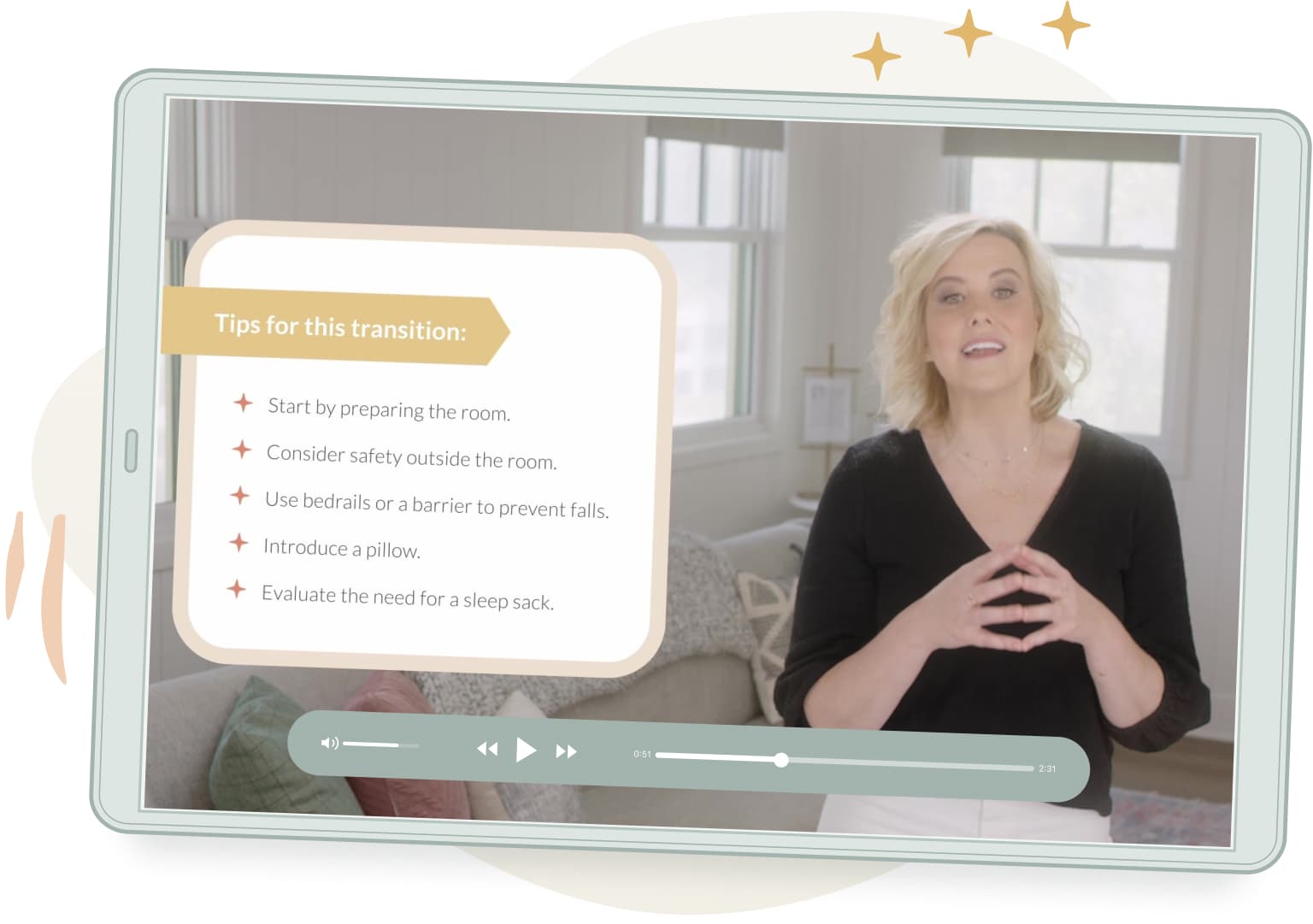Wondering what to do when your toddler won’t stay in bed? You’re not alone! This is one of the most common toddler sleep struggles. Toddlers are natural boundary pushers. This is how they learn and explore their world. But often, this desire for independence and control can impact your toddler's sleep. I can help.
Taking Cara Babies Classes
stars ( reviews)
If your little one’s sleep is a struggle, my classes can help. I’ll give you the tools you need to meet your toddler where they are developmentally and remain emotionally connected the entire time. It’s never too late to set loving boundaries around sleep to help your toddler become a great little sleeper. Choose your child's age get started:
Why does your toddler keep getting out of bed? How can you help everyone get a good night’s sleep in their own bed?anchor
1. Your toddler is struggling after transitioning from crib to bed.anchor
First, I always recommend making sure your toddler is truly ready to transition to a toddler bed in order to set everyone up for success. Staying in the crib a bit longer (if they can safely do that) may just be the answer.
If, however, staying in the crib is not an option or your toddler has already moved into their own bed, the next important thing is to establish firm, loving boundaries around nap time and bedtime. You can’t force a toddler to sleep, but you can make staying in bed a non-negotiable. How do you do that? Every time your toddler gets up and out of bed, you walk them right back to bed. You’ll want to be calm, non reactive, and firm. When getting out of bed receives no reaction and a simple walk back to bed, your toddler becomes less and less motivated to try. Now, you may need to do this over and over again for a bit, but over time, your toddler will learn that staying in bed is the only option for nap time and bedtime.

Toddler Sleep Training
stars ( reviews)
If you need more step-by-step guidance, know that my Toddler Sleep Training class will walk you through everything you need to know to set your toddler up for great sleep in their own bed.
Learn More2. Your toddler’s sleep environment needs to be adjusted.anchor
We want to be sure that the environment is conducive to great sleep.
For most toddlers, here's what that looks like:
a pitch dark room with no stimulation. This dark environment cues your little one that it’s time for sleep.
the humming of a sound machine. The consistent, shower-volume sound helps little ones fall asleep faster and minimizes stimulating noises.
a space free of exciting distractions. Take a look around your toddler’s room. Do you see any stimulating toys or decorations? Even if your toddler’s room is pitch dark, it can make it harder for your little one to sleep if they know those toys are there waiting for them. Have your child help you say “goodnight toys” by putting them away in the closet or toy bin during sleep and remind them they’ll be there to play with tomorrow.
a temperature comfortable for sleep. Between 68℉ and 72℉ degrees is typically the recommended temperature range for sleep (for all ages). However, your toddler can still be comfortable and safe even if that range doesn’t always happen. Just adjust their pajamas and bedding accordingly.
Expert Tip: You can still set up an ideal sleep environment even if your toddler prefers to sleep with a night light.
3. Your toddler’s sleep schedule needs to be evaluated. anchor
Often when a toddler won’t stay in bed for naps or at night, an adjustment to their sleep schedule can help. Why? Because an overtired child gets a surge of cortisol that acts as a "second wind" and makes them fight sleep. On the other hand, a child who isn't tired enough will find getting out of bed tempting as their body simply isn't ready for sleep.
Take a look at your toddler’s wake windows and total daytime sleep. I have a blog all about toddler sleep schedules for 2, 3, and 4 year olds to help you.
Keep in mind, most toddlers still need a nap until close to 4 years of age. Every child develops at their own pace though, so some may be ready to drop their nap a little earlier, and some will nap well past their fourth birthday.
If your toddler refuses a nap you know they need, a flexible bed time can help avoid overtiredness (Think as early as 6:00 or 6:30 pm.).
You may see these signs if your toddler is getting overtired at bedtime:

If your toddler is struggling with sleep, my Toddler Sleep Training class will teach you developmentally-appropriate strategies for independent nights, successful days, and smooth transitions through the toddler years.
4. Your toddler needs a consistent bedtime routine.anchor
Toddlers truly thrive on predictability and routine. Knowing what to expect at bedtime can make a big difference in sleep success. Having a consistent bedtime routine helps cue your toddler’s brain that sleep is coming, eases the transition between awake time and sleep time, and sets a loving boundary that helps your toddler feel secure.
A bedtime routine doesn’t need to be complicated. Simply follow the same steps in the same order each night to help your toddler understand your expectations around bedtime. Using a bedtime routine chart as a visual reminder can make bedtime easier, especially if transitions are hard for your toddler.
Expert Tip: I know that watching a show can feel like “wind down” activity before bed. But, the research shows that screen time before bed can actually make sleep harder!(2,3,4) When toddlers and preschoolers are exposed to screen time before bed, melatonin (the sleepy hormone) can drop by up to 88%(4). I recommend turning off screens at least an hour before bedtime to set your toddler up for a great night of sleep.(2)
Want a free printable toddler bedtime routine chart?
This downloadable chart includes BONUS tips on how to implement a visual bedtime routine with your toddler.
5. Your child is going through a toddler sleep regression.anchor
The toddler years are full of major developmental strides and big transitions. Your toddler’s blossoming imagination and growing sense of independence can make sleep a bit tricky. Major changes in routines, like adding a sibling, potty training, and starting preschool, can also lead to disruptions in sleep.
Some of the most common signs of a toddler sleep regression are:
Taking short naps, protesting naps, and/or refusing naps
Some toddlers may go through the 2 year old sleep regression, but because every child develops at their own pace, it’s possible to see a toddler sleep regression any time your little one is experiencing a growth spurt, developmental progression, or a peak in separation anxiety. Sleep regressions are often temporary and typically not a cause to make any changes in your toddler’s routines. If your toddler is testing boundaries during these changes, know that it’s normal and continue to prioritize sleep. Staying consistent can help a sleep regression pass more quickly.
If sleep has always been a struggle, please know it’s not too late to have a great sleeper. My Toddler Sleep Training class will teach you an emotionally-connected, holistic approach to setting your 2, 3, or 4 year old’s sleep up for success.
6. Your toddler is afraid of the dark.anchor
As parents, we want to do anything we can to help ease our child’s fears. When your toddler won’t stay in bed due to being afraid of the dark, here’s my advice: show your toddler why and how they’re already safe. Check the closet together. Take a look under the bed together. Show them how safe their room is, including their own bed.
Imagination begins to develop around 2-2.5 years of age and continues to grow as they get older. This major development can sometimes lead to a toddler being afraid of the dark. There are a few other factors that can also add to a fear of the dark:
Being overtired. When a toddler is overtired, their body releases stress hormones(1) that can heighten anxieties.
Being undertired. If your toddler isn’t tired enough at bedtime, they may spend more time laying in bed awake, which allows for more time for their imagination to run wild.
Screen time. Sometimes, something that seems harmless to us, may actually be scary to your toddler and can increase a fear of the dark. Keep an eye on what your little one is seeing on the screens (or even in the background). I recommend turning off screens at least one hour before a nap or bedtime.
7. Your sick toddler won’t sleep alone. anchor
Illness can cause sleep disruptions, and these sleep disruptions may have your toddler getting out of their bed for comfort. If your toddler is sick, they may need extra support to meet their physical and emotional needs.
Here’s what I recommend when your sick toddler needs you nearby in the night: instead of bringing them into your room, go into their room. Take a mattress and sleep on the floor next to their bed. This will help them sleep better during the illness while allowing you to remain close enough to meet any need they may have.
Expert Tip: Once your child is well again, return to your established healthy sleep habits. For most, it only takes a few days to get right back on track following an illness.
What can I do if my toddler still won’t stay in bed?anchor
It’s a normal part of toddler development to test boundaries, even when you’ve done all of the prep work and set clear expectations. I know this can be frustrating, but having a plan for when those boundaries are being pushed is necessary for success. Your plan could be as simple as: Any time your toddler gets out of bed, you’ll calmly walk them back to bed, tuck them back in, and leave the room.
If you need more help with determining a plan that’s best for your family, know that my Toddler Sleep Training class will help you do just that. I’ll walk you through a holistic and customizable, step-by-step plan to look at awake time, sleep time, toddler behavior, and so much more to see restful nights and naps for your little one. Yes, it really is possible to help your toddler get a good night’s sleep in their own bed.
References
4 Sources
Wright Jr. et. al. (2015). Influence of sleep deprivation and circadian misalignment on cortisol, inflammatory markers, and cytokine balance
Hartstein et. al. (2022). High sensitivity of melatonin suppression response to evening light in preschool-aged children
Janssen et. al. (2019). Associations of screen time, sedentary time and physical activity with sleep in under 5s: A systematic review and meta-analysis
Lockley et. al. (2003). High Sensitivity of the Human Circadian Melatonin Rhythm to Resetting by Short Wavelength Light
Keep in mind that the information and content on this blog is for informational purposes and should not be considered medical advice. If you have questions about your child, please reach out to your doctor.








